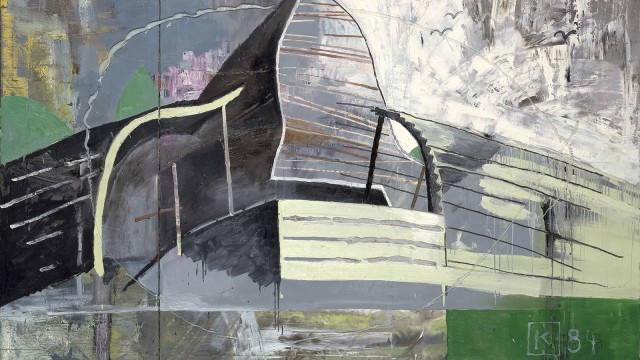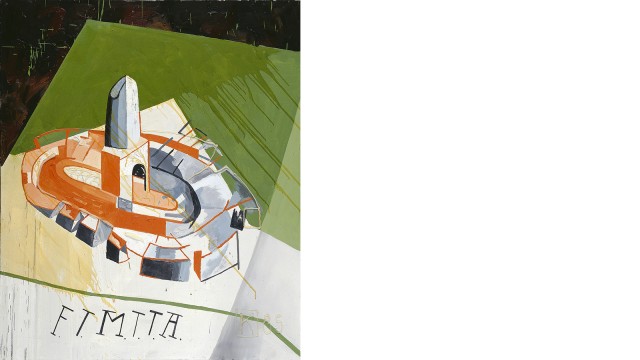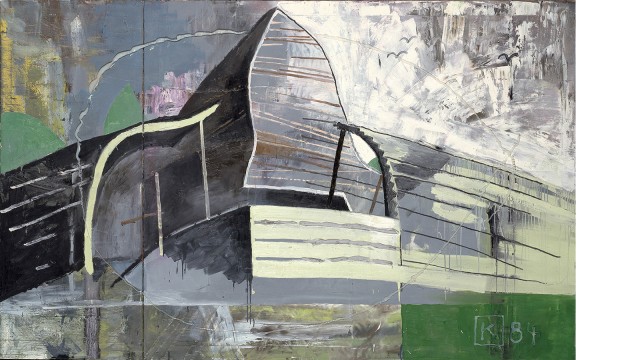
Works in the Collection
Martin Kippenberger started taking photos of what he regarded as the remarkable aspects of public space and seeking out dysfunctional spaces already during his time as a fine arts student. From the mid-1980s, architecture and public space recurred in various forms as places of social life in Kippenberger’s work, always in search for their respective meaning and function. Kippenberger’s two paintings, "From the Misery to the Authority" and "Organische Architektur in Ungarn", are clear examples of this artistic analysis. "From the Misery to the Authority" depicts an oval building that is dominated by a tower in the center. The structure is similar to a panopticon, which the British philosopher and founder of utilitarianism, Jeremy Bentham, developed at the end of the 18th century as an ideal layout concept for the construction of prisons in order to have as many people as possible monitored by just one guard at all times. The picture's title, “From the Misery to the Authority” – and back again, it could be added – refers to the disciplinary order embodied by the building itself: with its oval path, the structure also has the nature of a stadium in which running around in circles can be watched and overseen.

The work "Organische Architektur in Ungarn" also conveys a pointedly sociopolitical commentary. The subject matter of the picture is a sculptural complex of buildings that rises up to the sky from a cubic porch in a slightly undulating manner, and has two roughly outlined birds flying in the section on the right where off-white paint has been applied with a palette knife. With this summarily sketched arrangement Kippenberger defines in a painterly manner the concept of ‘organic architecture’, which references the ideal of attaining harmony between buildings and nature as it first arose in architectural theory at the end of the 19th century. For instance, the building materials themselves were meant to be used to develop a natural and vivid shape that is appropriate to them, enabling the social role fulfilled by the building to be experienced positively in a universal whole. It is a contradiction in terms that in Communist Hungary of all places around 200 buildings of organic architecture were planned and constructed in many locations between 1959 and 1989, with the anthroposophically-oriented architect Imre Macovecz as one of its most prominent exponents there. After all, how can harmonious experience and spiritual understanding in the sense of an anthroposophically influenced, organic architecture actually be possible in a repressive state if the state doctrine is merely camouflaged with this idealistic building concept? In 1988, Kippenberger’s study of the social and political contexts of architecture and their connotations ultimately led to his art book entitled "Psychobuildings”, which set out an interim summary with a total of 114 black and white photographs.

The artistic reflections of Martin Kippenberger also manifested themselves in his use of unconventional painting materials since around the mid-1980s, such as rubber and silicon paste, with which he accentuated his paintings in purely formal terms or applied the paste to write slogans on them. Also, he often signed with silicon, as can be seen in the two architecture paintings in the LBBW Collection. Kippenberger also added Latex to his unconventional range of materials around 1990, during his stay in Los Angeles. While painted canvases were initially covered only with a latex sheath in the manner of a condom, this was taken a step further from 1991 onwards, leading to the group of around 50 “Gummibilder”. These complex picture objects made of pigmented natural rubber in beige, black or gray are characterized by a distinct surface relief, part of which is supplemented by protruding three-dimensional elements. For instance, along with numerous hands and pimples, a beer mug, and a host of rectangles, the surface of "Ohne Titel" (1991) has the scrawled sentence “Don’t call me, I’ll call you” spread across the surface. Set aside and on the bottom left edge of the picture, there is also an unexplained "XO" above a small pouch that looks like an inside-out inner pocket.
_1991_wrlb_1600x900_estate-mk_image_w640_m.jpg)
“Irony consists of jokingly saying the opposite of what you think, or of what you want others to think”, according to the French grammar specialist Pierre Fontanier’s early definition of this stylistic device, which Kippenberger applies in this work and the sentence. After all, this snappy phrase is bare-faced irony, and does not express a desire to talk again at all. The fist emerging from the slit in the picture conveys defiance, whereas the street lamp worming its way out of the slit and extending limply to the floor suggests the exact opposite. Both the fist and the street lamp are emblems which Kippenberger uses to charge the iconography of this work with references to his oeuvre and himself. The raised, clenched fist was first used in the political iconography of the labor movement, and Kippenberger had already introduced it as a thematic element of his work by 1991. By contrast, Kippenberger was the first to lend artistic meaning to the street lamp, as he framed it as the last support of the drunk, and even made it the subject of a 1992 exhibition entitled “Mensch, geht mir ein Licht auf. Gut ausgeleuchtete vorweihnachtliche Ausstellung an der Leopoldstraße” (Gosh, it Dawns on Me! Well-lit Pre-Christmas Exhibition on Leopoldstrasse). With regard to Kippenberger’s entire oeuvre, the street lamp appears so frequently that it seems as if the artist was quoting himself.
The LBBW Collection also contains some of Martin Kippenberger's "Hotelbriefzeichnungen”, which practically constitute an oeuvre within his oeuvre and were produced from 1986 onwards, initially on receipts from the “Othon Hotel” in Salvador. In these first drawings, the artist sketched floor plans of his apartments, hotels, and studios. Over time, the subjects of the "Hotelbriefzeichnungen" additionally included references to completed sculptures, series of paintings or printed invitation cards. The use of stationery from every corner of the world gives the deceptive impression of the artist as well-traveled and always on the move, whereas it was often his friends who collected and brought the paper back for him. The drawing "Ohne Titel (Hotel Robert Mayer)" harks back to the "Hand-Painted Pictures" series, reusing a self-portrait as a runner ready to start.
_1995_wrlb_1600x900_lbbw_image_w640_m.jpg)
Already with his first cycle of paintings, produced in 1976 and entitled "Uno di voi, un tedesco in Firenze", Martin Kippenberger addressed the question of the pictorial value of motifs and forms of presentation that has always been discussed in art history through the centuries and that repeatedly became crucial for his work. Kippenberger used his time in Florence as an opportunity to capture portraits, plated meals on checkered tablecloths, street views, illuminated shop windows, interiors with ceiling lamps, and much more from everyday life or from themes taken from postcards and painted them in graduated shades of gray on numerous canvases in a consistently maintained format of 60 x 50 cm. In contrast with Gerhard Richter’s ((Verlinkung auf ENG ES Richter)) "48 Porträts" for the German pavilion at the 1972 Venice Biennale, and which served as the template for Kippenberger, Kippenberger’s canvases neither focus on portraying men of history, nor do they have the homogeneous application of paint or the soft-focus blur effects one can find in Richter. Instead, some of the subjects are depicted in thick impasto, sharp chiaroscuro contrasts, and occasionally give the impression of having been painted very hastily. With Kippenberger’s work, the range of classic genre painting is therefore broadened with everyday and trivial motifs that target the widely established self-image of society with the stylistic devices of irony or pastiche.
Biography
Martin Kippenberger (1953–1997): Born in Dortmund, grew up in Essen. His family were regular visitors to the local Folkwang Museum. 1962–1968 Attends school in the Black Forest and the Westerwald. 1972–1976 Studies at the Hochschule für Bildende Künste in Hamburg under Rudolf Hausner and Franz Erhard Walther. 1976 Moves to Florence, 1977 Returns to Hamburg, becomes acquainted with Werner Büttner and the brothers Albert and Markus Oehlen. 1978 Moves to Berlin, opens "Kippenbergers Büro" with Gisela Capitain, organizes exhibitions, readings, film screenings, and concerts. Co-owner of the Kreuzberg club "S.O. 36”, helps to arrange and takes part in the club’s activities. 1979–1980 Travels through the US and to Hawaii, returns to Berlin, spends time in Paris. 1981 Leaves Berlin. Several weeks in Tuscany are followed by the first of many stays in St. Georgen in the Black Forest, with the Grässlins, a family of collectors. 1982 First solo exhibition at the Kunstforum Rottweil, 1984 First major joint exhibition "Wahrheit ist Arbeit" with Albert Oehlen and Werner Büttner at the Folkwang Museum, Essen. 1985 First solo exhibition in the US at Metro Pictures, New York. 1986 First solo museum exhibition "Miete – Strom – Gas” at the Hessisches Landesmuseum, Darmstadt. 1990 Visiting professor at the Städelschule art school in Frankfurt. 1991 Solo exhibition at the SFMOMA, San Francisco. 1991/1992 Professor of the "Erfreuliche Klasse Kippenberger” at the Gesamthochschule Kassel, first major project in the public sphere with black “Latexbilder” for the Wiener Festwochen. First of several stays on the Greek island of Syros, founds the MOMAS (Museum of Modern Art Syros) there in 1993 in a covered, wall-less concrete building shell. 1993 Solo exhibition at the Centre Georges Pompidou, Paris. Installation of the first "Metro-Net" fake entrance on Syros. Study of Franz Kafka's unfinished novel “Amerika” leads to the first presentation of "The Happy End of Franz Kafkas ‘Amerika’” at the Museum Boijmans van Beuningen, Rotterdam in 1994. Also explores the topic of “Schrebergarten”. 1995 After a spell in Tokyo, moves to Burgenland in Austria. 1996 Starts the “Eier-Bilder” group of works and the thematic cycle “Das Floß der Medusa” after Géricault. 1997 Kippenberger opens his last two solo museum exhibitions in his lifetime at the Musée d’art moderne et contemporain in Geneva and the Museum Abteiberg in Mönchengladbach.
